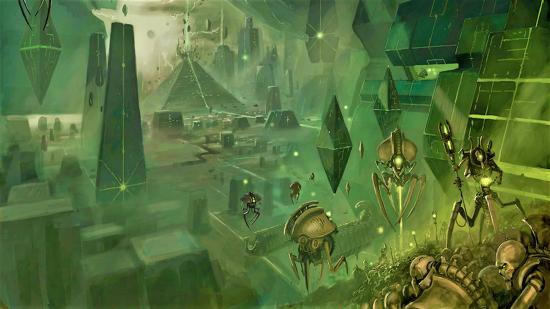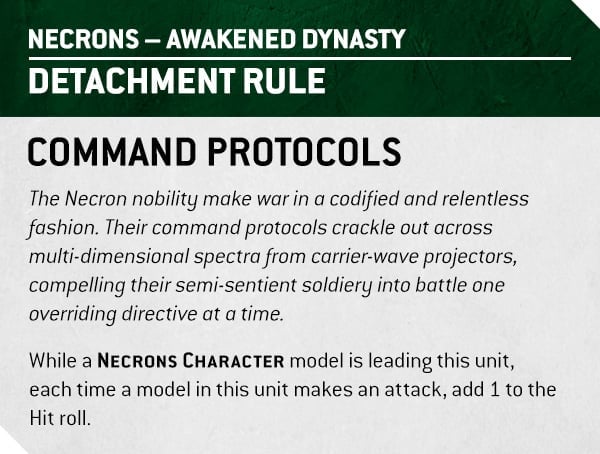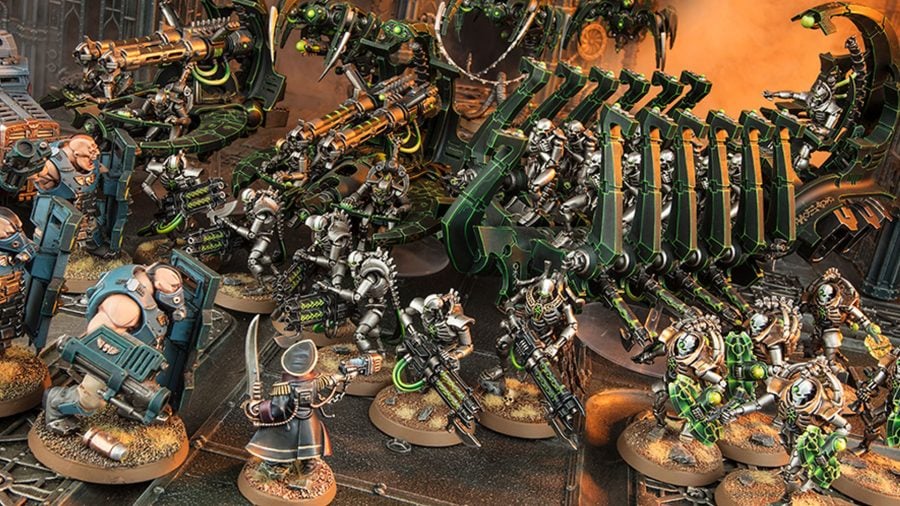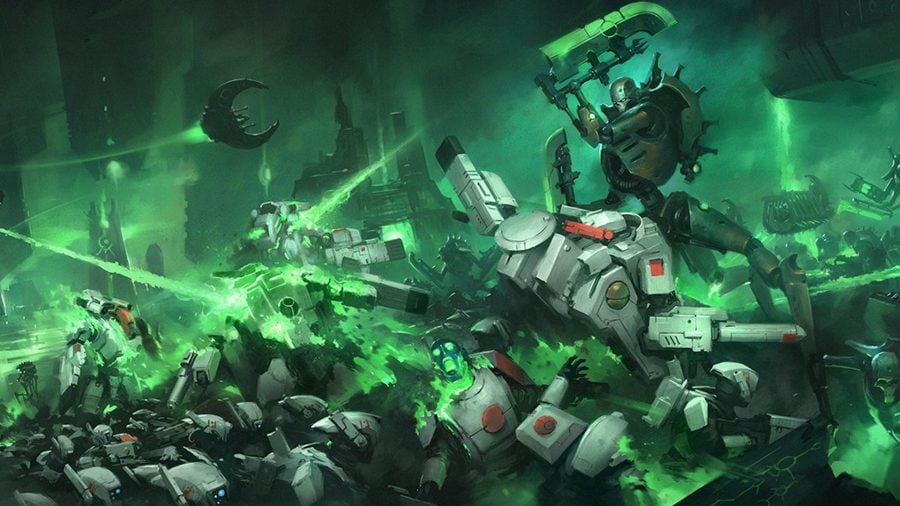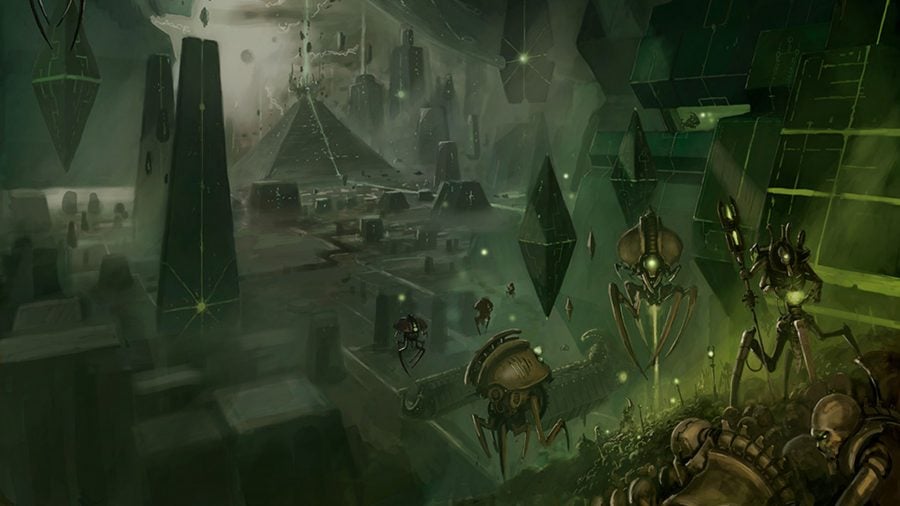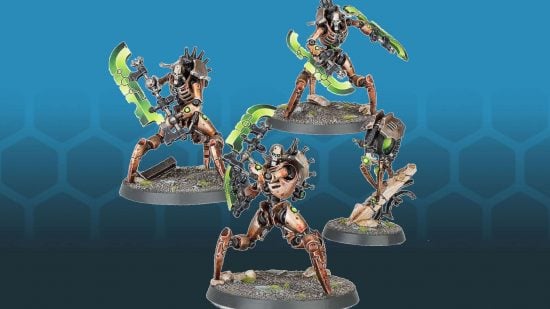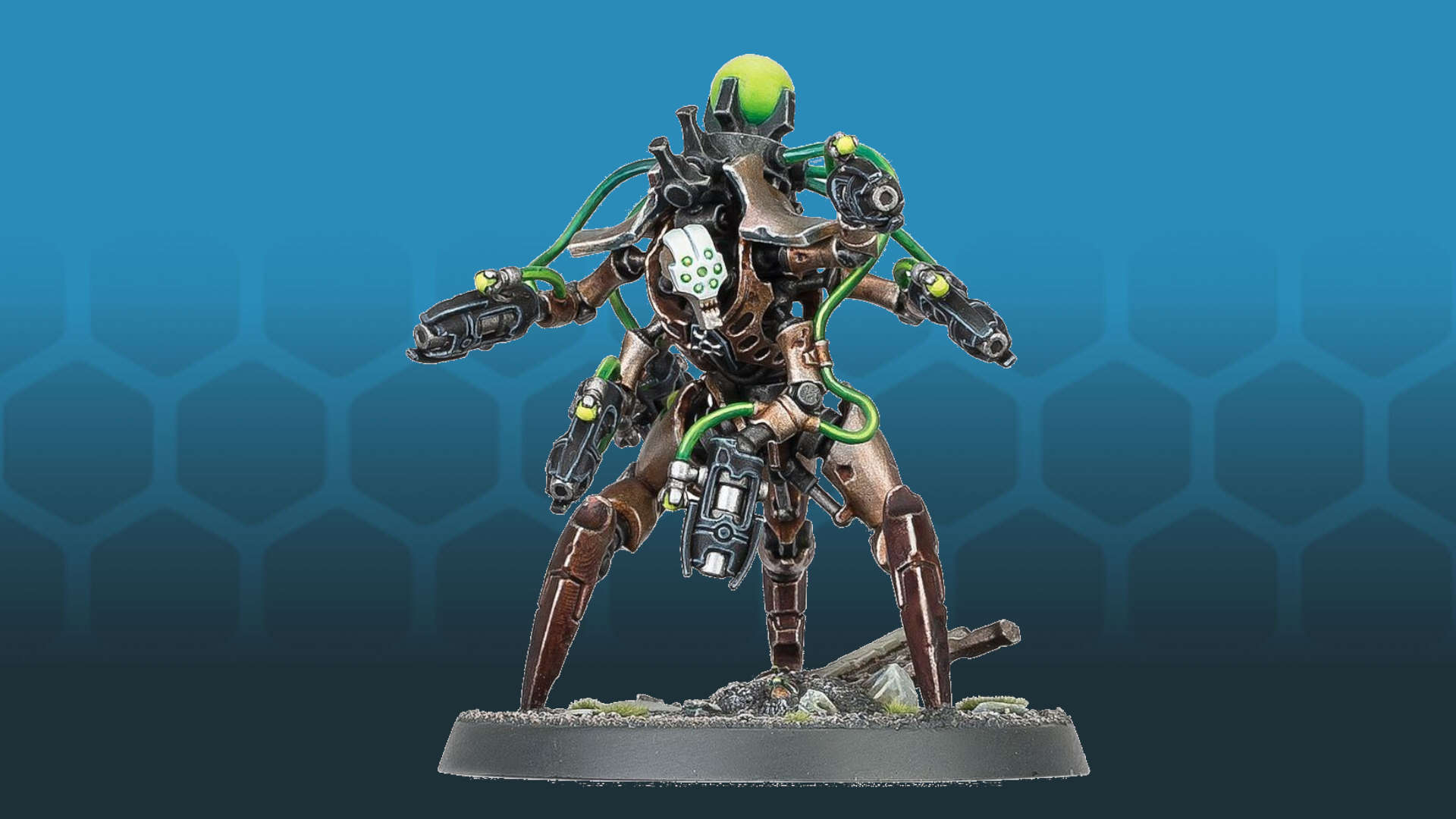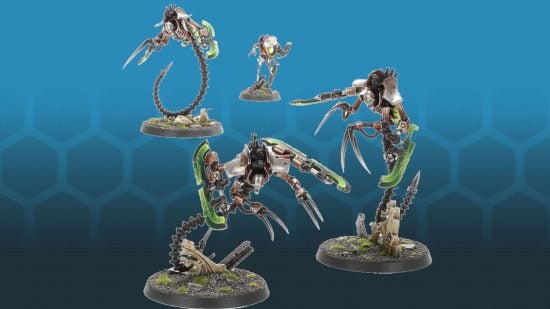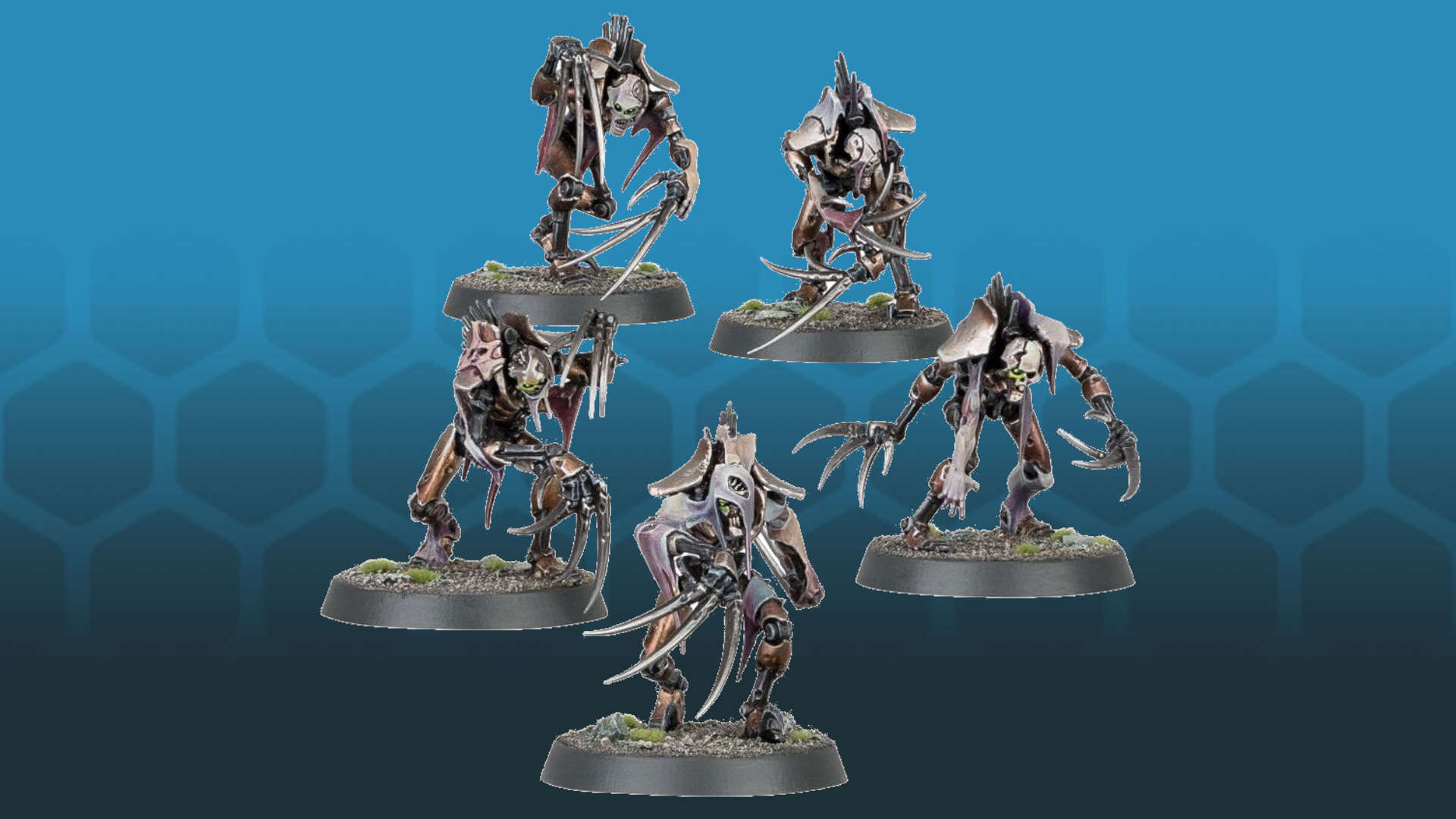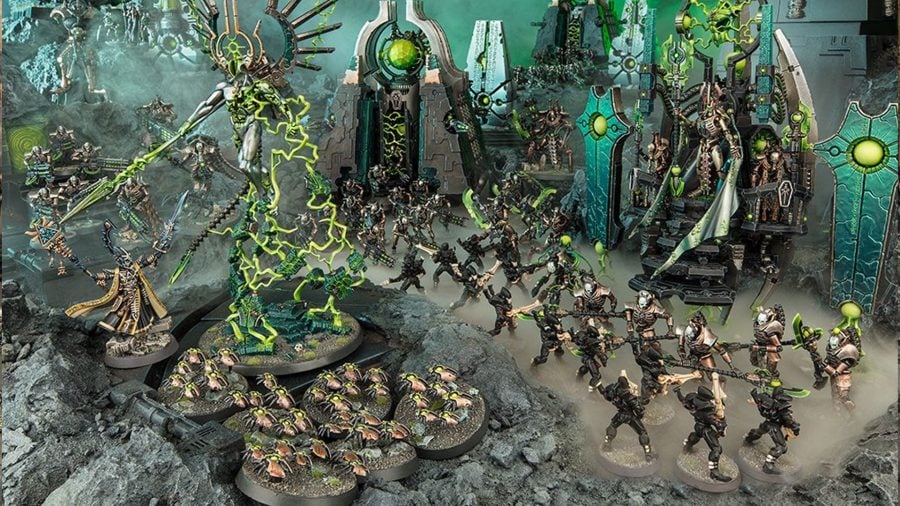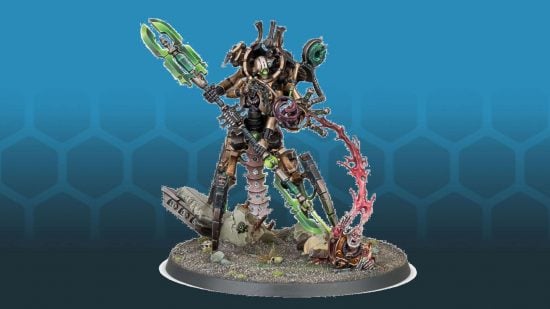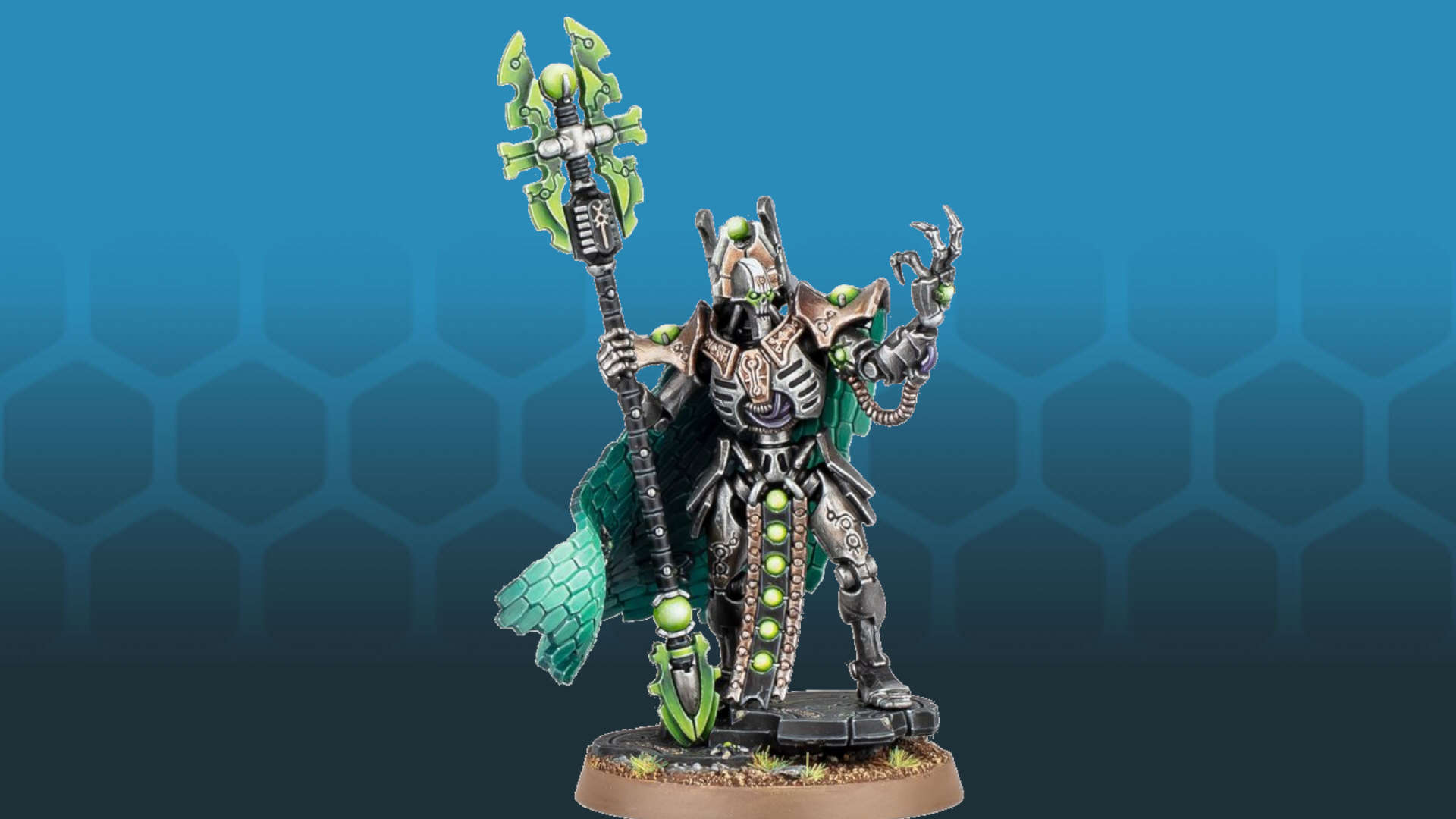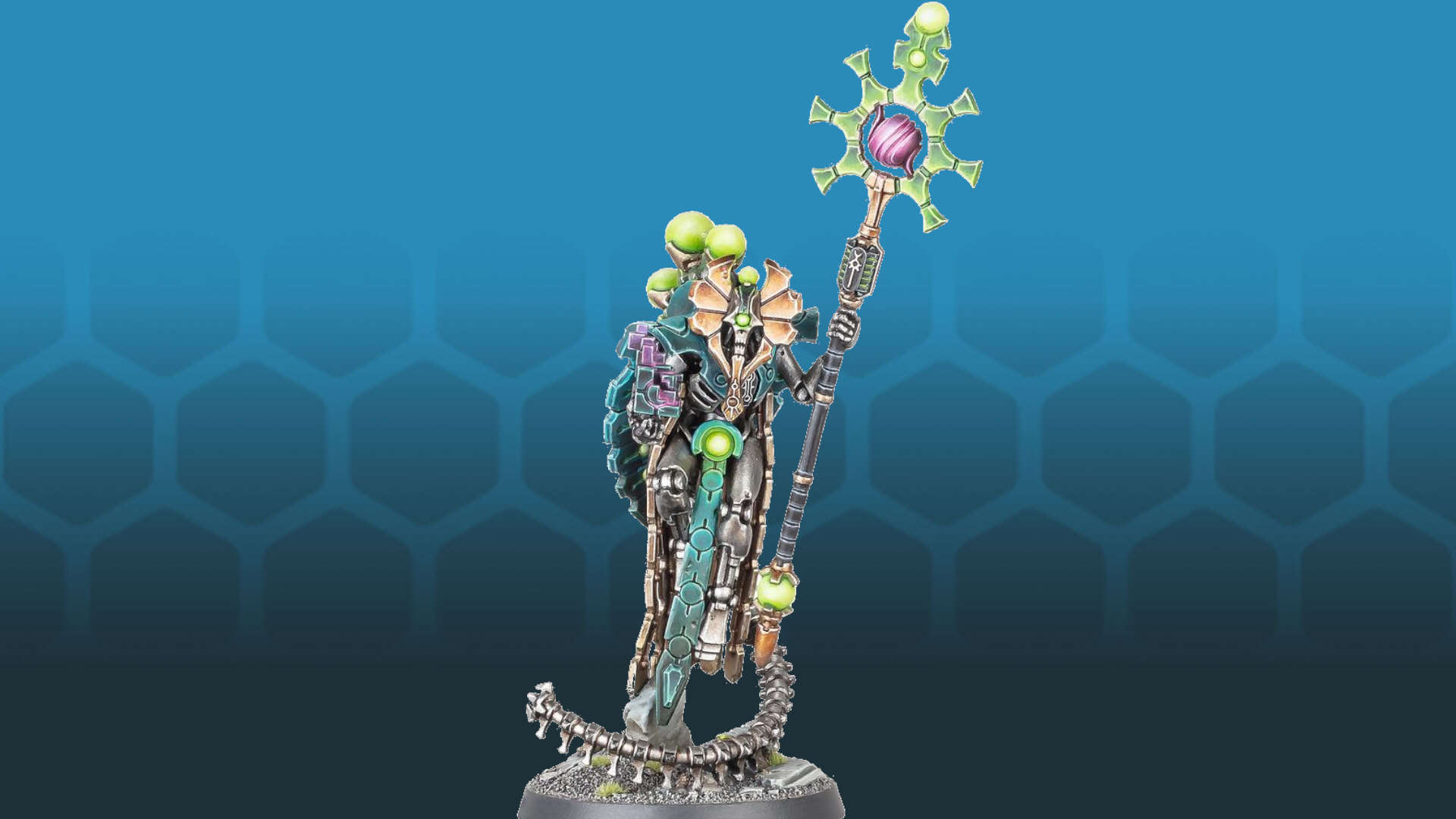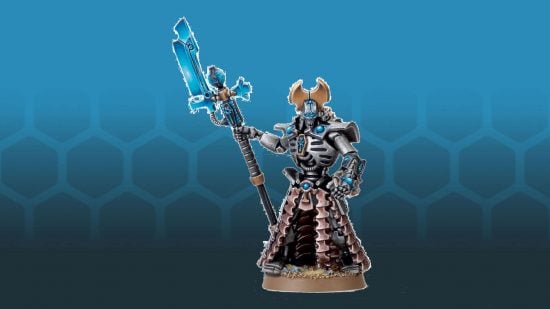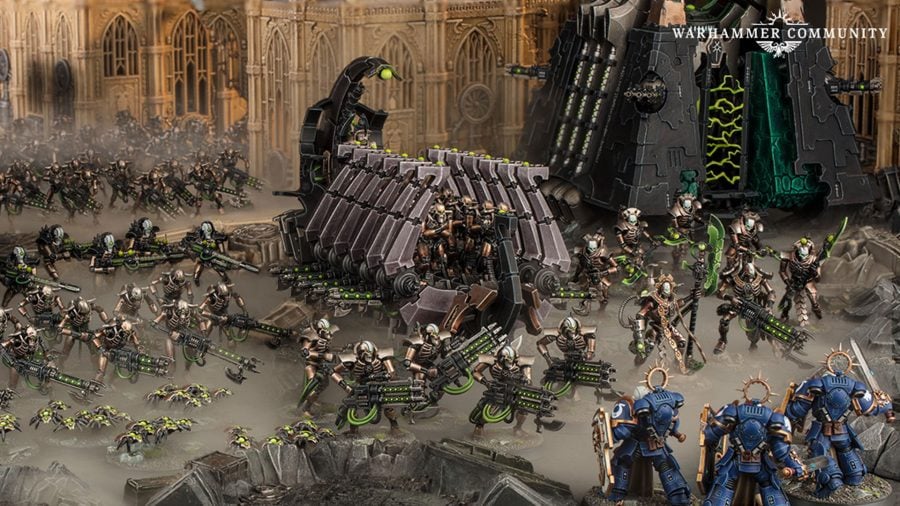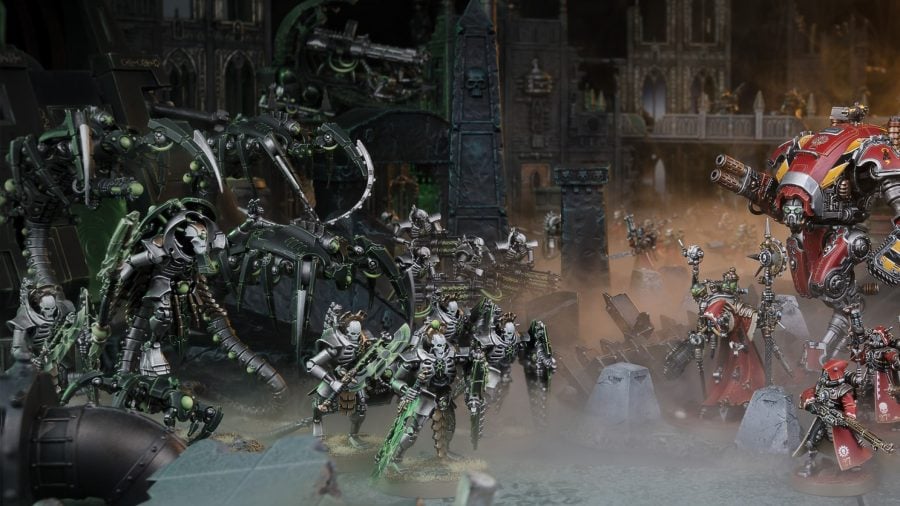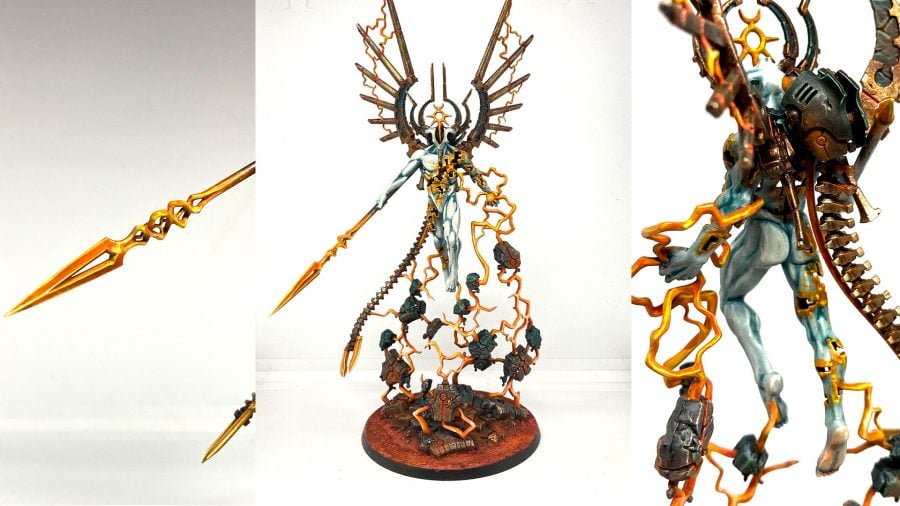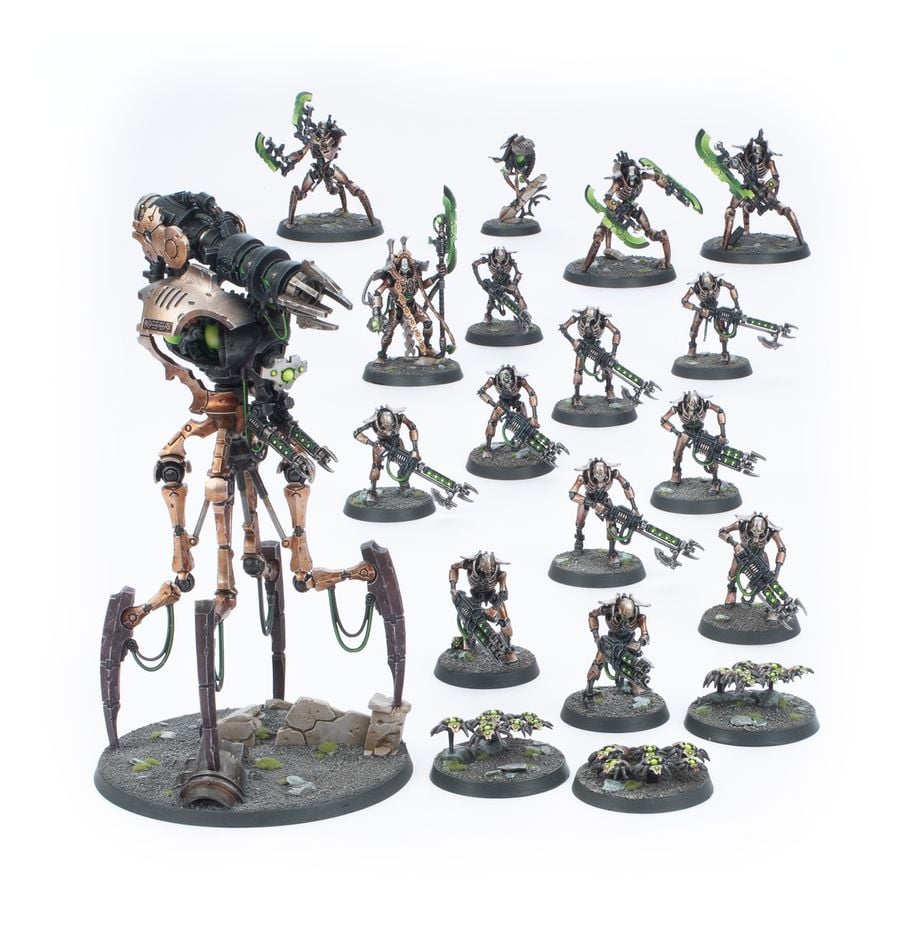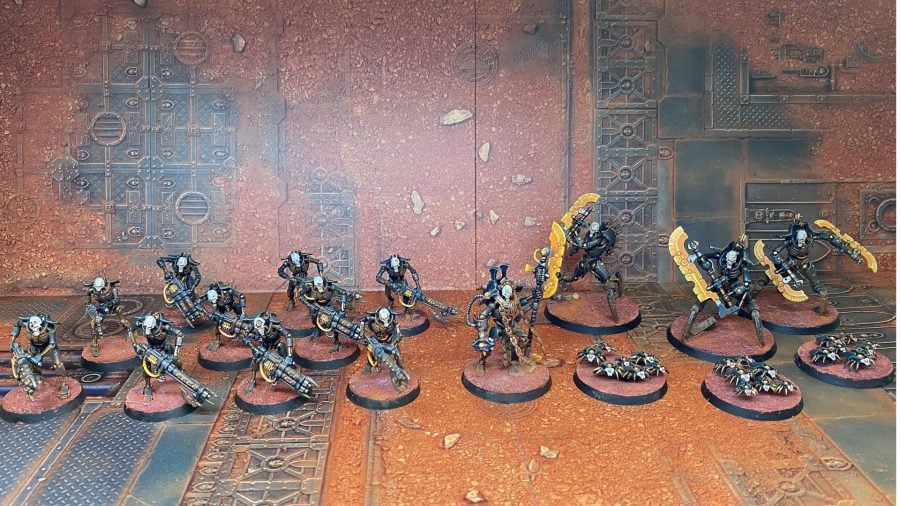Wakey wakey, rise and shine. It’s time to rise from a slumber of over 60 million years. Luckily you won’t need to worry about bed head because, as one of the Necrons, you were forced long ago to give up your flesh (and hair) in the process of biotransference, and become a living metal skeleton, immortal and fearsome.
The Necrons are the Warhammer 40k Xenos equivalent of the Undead in many fantasy settings. Taking inspiration from both the Terminator movies and the Egyptian dynasties of old, these immortal cybernetic beings rise up from long-buried tombs, marching into battle with arcane technologies beyond the ken of mortal men. If that doesn’t sound quite right for you, we have a whole list of other Warhammer 40k factions for you to consider.
With the launch Warhammer 40k 10th edition, the full Warhammer 40k 10th edition Necrons rules were available to download from the Warhammer Community website. You can still download free Necrons 10th edition index datasheets from the Games Workshop website, but they’ve been superceded by the Necron Codex, which released late in 2023.
Here’s everything you need to know to get started with Warhammer 40k Necrons lore, models, and tactics.
- Necrons Reanimation Protocols
- Necrons Detachments
- Necrons lore
- Necrons characters
- Warhammer 40k books starring Necrons
- How to play Necrons
- Necrons hobby tips
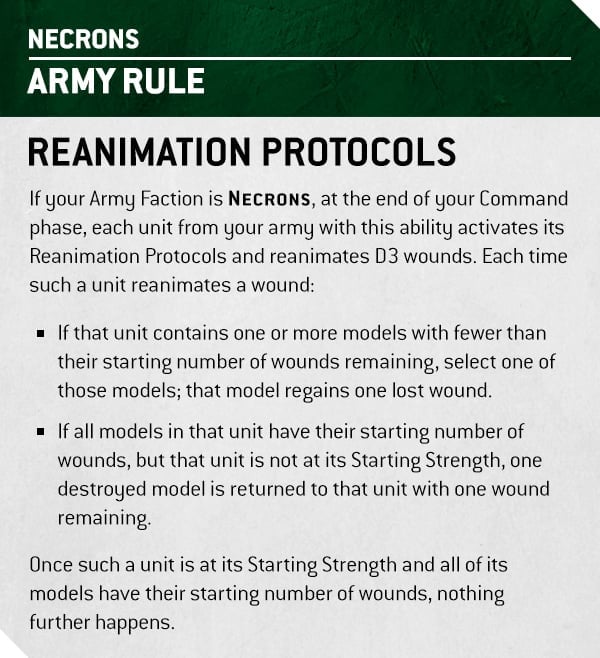
Reanimation Protocols
The Necrons’ trademark self-resurrecting super-power is Reanimation Protocols. At the beginning of each turn you roll for a D3 for every single unit, and heal wounds or reanimate models up to the die result.
Infantry and Vehicles alike have the Reanimation Protocols rule, as evidenced by the newly revealedthe Monolith datasheet. It’s crucial for opponents to never leave a Necron unit half killed.
Necrons Detachments
The Necrons can pick from five Warhammer 40k detachments when constructing a force. Each one grants the army an extra rule, as well as providing enhancements and stratagems, that lean into one specific playstyle.
Necron Awaked Dynasty Detachment
The Necrons’ debut detachment, ‘Awakened Dynasty’, appeared in the Necrons Index, and has been slightly updated for the Necrons Codex. Command Protocols rule to the army. This give any unit with a character leading it a blanket plus one on all to-hit rolls, as well as any other buffs that Leader provides. This is a dead simple, and very powerful, buff that incentivizes lots of characters in your lists.
Awakened Dynasty Necron Stratagems
| Stratagem | CP cost | Effect |
| Protocol of the Eternal Revenant | 1 | Once per battle, after a Necrons infantry character is destroyed, set them back up with half their starting wounds close to where it was destroyed. |
| Protocol of the Hungry Void | 1 | +1 Strength to a unit’s melee weapons for one turn; if they’re lead by a character, their AP improves by one as well. |
| Protocol of the Conquering Tyrant | 1 | A Necron unit can re-roll hit rolls of one with shooting attacks targeting a unit within half range, or all hit rolls if they’re lead by a character. |
| Protocol of the Undying legions | 1 | When an enemy destroys one or more models from a Necron unit, that unit reanimates D3 wounds, +1 if lead by a character. |
| Protocol of the Sudden Storm | 1 | In the movement phase, pick a unit; its ranged weapons gain Assault this turn. If lead by a character, you can re-roll Advance rolls for the unit. |
| Protocol of the Vengeful Stars | 1 | After your opponent destroys one of your units with shooting, a unit led by a character within 6″ can return fire. |
Awakened Dynasty Necron Enhancements
| Enhancement | Effect |
| Veil of Darkness | Once per Battle, at the end of your opponent’s turn, if the bearer isn’t engaged remove it from the battlefield; it enters from Reinforcements next turn anywhere more than 9″ away from all enemies. |
| Nether-Realm Casket | While the model is leading a unit, that unit has Stealth. |
| Phasal Subjugator | Non-character Necrons within 6″ of the bearer get +1 to Hit |
| Eneagic Dermal Bond | Feel No Pain 4+ |
Necrons lore
Necron lore is a little twisted, as they’ve been retconned more than once. For simplicity’s sake, we’re focusing on the current version of their lore.
At the dawn of time, the Necrontyr were a proud, star-striding race, cursed with brief lifespans due to incurable genetic illnesses that left them wracked with cancer. Their obsession with venerating death was the only thing that matched their penchant for internal politicking, and internecine conflicts were causing the empire to slowly fragment.
To unify them, Szarekh, one of the many Silent Kings of the Necrontyr empire, thrust them into conflict with The Old Ones, the technologically advanced race responsible for the creation of the Webway, the network of tunnels through the Warp.
This war was fought over the key to immortality itself, and was all-consuming. Faced with defeat, Szarekh chose to ally with the C’tan, duplicitous star-eating beings, who subsequently gifted the Necrontyr immortality via the horrors of biotransference, for a price: their souls.
Records of the War In Heaven are largely apocryphal and fragmented, but regardless of the outcome, the Necrons hunted down the remaining C’tan, and either enslaved or destroyed them.
Szarekh, now in complete control of the legions of Necrons before him, devised a great plan, and ordered his subordinates to create tomb worlds, in which they were to slumber for 60 million years. Szarekh himself left the galaxy for the void of space beyond the Galactic rim, with unknown purpose.
Thousands of millennia later, in the late 41st millennium (or early 42nd, depending who you agree with) he has returned (though no-one knows precisely why). Chief amongst assumptions is that he witnessed the true vastness of the Tyranid fleets, floating dormant towards the galactic core, and returned to save his civilization from being devoured – but perhaps there were strands of the Great Work to ward the galaxy from chaos that could only be completed on the galactic rim.
Necron forces have now begun mobilising across the galaxy, under the controls of the many mad Triarchs who control the great Dynasties. While they are technically all under the reign of Szarekh, the Silent King, every dynasty believes itself far better than the next.
Still, they present a threat to the forces of the Imperium, and their ability to make use of the material Blackstone even makes them a threat against the insidious forces of Chaos.
Necrons Destroyer Cults
No Necron survived their race’s long sleep with their sanity in tact. The madness of the Destroyer Cults manifests in an apocalyptic loathing for all forms of organic life, from the ‘lesser’ sentient species that have occupied the galaxy in the Necrons absence, down to the smallest microbe.
With no nostalgia for their lost flesh-forms, and their singular desire being to eradicate all organic life from the galax, the Destroyer Cults are prone to radically altering their body shape. Some favor ranged weapons, like the centauroid hovering Heavy Destroyer weapons platforms, and six-armed, six-gunned Hexmark Destroyers.
Others prefer the intimacy and surety of melee, like the serpentine Ophydian Destroyers, or the blade-limbed Skorpekh Destroyers.
Necrons flayed ones
Where the Destroyers revile flesh, the Flayed Ones revel in it. Their madness manifests in insatiable hunger and an unconquerable desire to reclaim the flesh they have lost. They descend upon organic foes in a flurry of bladed limbs, their necrodermis draped in the dripping skins of those unfortunate enough to have already faced them.
Though they have no mouths with which to consume their foes, they can be found at the end of every battle scooping the remnants of their enemies into their face plates in a mockery of feeding.
Necrons characters
During their long slumber, many Necron characters went mad – their neural circuits corrupted by the long sleep, entropy slowly ruining them. As such, a wide cast of characters exist within their ranks, from obsessives to strategic geniuses. All of them are mighty warriors, with critical flaws – for a tragic streak runs through the Necrons, and finds itself most prominent in its roster of flavourful characters.
Szarekh, The Silent King
Szarekh the Silent King is the most advanced and dangerous Necron of them all. An android so complex in creation, he is beyond the reckoning of most other life forms. His exceptional new model in 9th Edition sees him float into battle with his Triarch, on a throne sustained by an enslaved C’tan – brutal in combat, a powerful tactical centrepiece, he’s a great character to build towards.
Illuminor Szeras
Illuminor Szeras is the Necron master of all things biotransference: a mad doctor, if you will, obsessed with tinkering with living metal, he takes inspiration from other life forms (by studying them as he atomizes them) to improve the necrodermis of the dynastic forces.
Trazyn the Infinite
Perhaps the most well known of all the Necron characters, Trazyn the Infinite is a kleptomaniac (sorry, ‘archivist’), who creates grand ahistorical dioramas in his giant museum palace. In battle, he transfers his intellect to different constructs when defeated, cackling as his foes try in vain to kill him.
Imotekh the Stormlord
A walking supercomputer, Imotekh the Stormlord is perhaps the Necrons’ greatest tactical mind. Woken by a lesser Necron to fight in a petty conflict in the Sautekh Dynasty, Imotekh became the Phaeron of that Dynasty in short order, thanks to his tactical acumen.
Orikan the Diviner
A Chronomancer of most prodigious skill, Orikan the Diviner is a prophet who has not forgiven Szarekh for submitting to the will of the C’tan. A grand manipulator, he alters the flow of battle and time itself with his skills, steering the galaxy to some unknown temporal destination.
Anrakyr The Traveller
Anrakyr The Traveller is considered perhaps the mightiest of all Necrons by some, and a brigand by others. Awoken in fine health (for a Necron), Anrakyr tasked himself with unifying the remaining Necron forces. Travelling from one tomb world to another, he wakes Necrons from their stasis, demanding a tithe of warriors before he moves on. This makes him a little contentious.
Nemesor Zahndrekh
Nemesor Zahndrekh lost his mind upon reanimation; unable to see the universe as it currently is, he sees his foes as honourable Necrontyr, his consciousness unable to conceive of the cruel reality inflicted on his race. Despite this, he is a keen tactician, one of the greatest the Necrons have ever seen.
Vargard Obyron
Zandrekh is protected by his loyal Vargard Obyron, who shields him from other Necrons who find Zahndrekh’s madness a liability, and enemies who see him as a prime target.
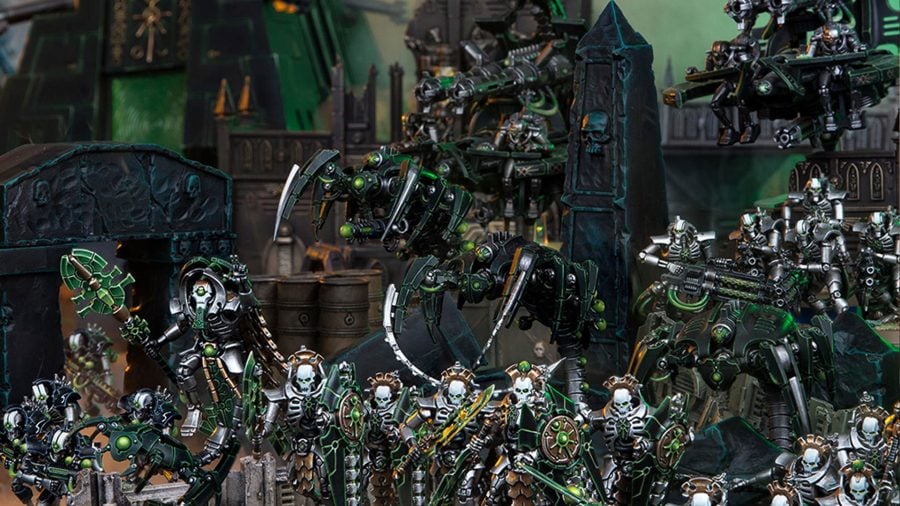
Warhammer 40k books starring Necrons
There aren’t many Warhammer 40k books starring Necrons, but the ones that do exist are fantastic.
Robert Rath’s ‘The Infinite and the Divine’ features a ten-thousand year war between Trazyn the Infinite and Orikan the Diviner over a priceless relic. Trazyn thinks it belongs in a museum (his museum), Orikan thinks it holds the key to unlimited power, and they’re both wrong… It is both epic and hilarious.
Nate Crowley’s duology Twice Dead King: Ruin and Twice Dead King: Reign is essential Necrons reading. The outcast Necron prince Oltyx must return to his throne world to warn his father of a devastating Imperial crusade – but something is deeply rotten at the heart of the Empire. By turns chilling, melancholy, hilarious, and epic, this brings the horror of Necron existence into crystal focus.
How to Play Necrons
Necrons are a formidable force on the tabletop, incredibly durable thanks to all-round good saves, and the faction’s unique Re-animation Protocol rules. They benefit from largely good shooting – if only at shorter ranges compared with other shooty armies – but also surprisingly good melee, in the form of the new Skorpekh Destroyers, plus a number of decent buff characters, such as the Technomancer and Chronomancer.
They can also field a number of interesting tactics, including a few that are potentially game-changing such as the Expansionist battle traits that buff movement, and improve the Objective Secure rules for the troops with it.
Owing to their reliance on close- and mid-range weaponry, Necrons like to take advantage of the new, smaller table sizes – sitting on objectives and whittling away at foes as they weather the storm of return fire and melee.
The main unique special rule for Necrons is Reanimation Protocols. This is a powerful rule that triggers in melee and shooting phases, allowing for exceptional durability. Despite the majority of their forces being unkillable damage sponges, with little in the way of return fire compared to more damage focussed armies, they do have their damage spikes: the C’tan Shard of the Nightbringer is one of the strongest melee units in the entire game right now, and the Void Dragon is no slouch, either.
Armies tend to be built with a focus towards overwhelming tides of troops of various forms, or towards a handful of standouts, such as C’tan Shards, Canoptek Doomstalkers, and Doomsday Arks. As previously mentioned, Skorpekh Destroyers are the hot pick: tough to kill, strong in melee. Take them in a unit of six, and these feisty, many-legged blenders are almost a must-have unit for any Necron force.
The bottom line is simple enough: although Necrons are fairly technical, they are forgiving due to their durability, and the brute force of their weaponry.
Necrons Combat Patrol Box
Games Workshop’s new Combat Patrol boxes are the ideal starting point for new Warhammer 40k players, or those looking to move into a new army. The Necrons Combat Patrol box can be used as it is for standalone games in the Combat Patrol format, or as the basis of a bigger army.
The Necrons Combat Patrol box contains 19 easy to build plastic kits. It contains :
- Necron Overlord x 1
- Necron Skorpekh Destroyers x 3
- Plasmacyte x 1
- Canoptek Doomstalker x 1
- Necron Warriors x 10
- Scarab Swarms x 3
You can download the datasheets for Combat Patrol Necrons via this link. These are for use in games against other Combat Patrols- slightly different datasheets apply to full games of 40k.
Necrons Hobby tips
As with most armies, Games Workshop shows off a variety of paint schemes for the various Dynasties in the Codex, and via the Warhammer YouTube. As of their introduction as part of the 9th Edition starter, Necrons have been designed to be fairly easy to paint – more so, even, than their older models.
They take a heavy wash and a drybrush over metallics really well, especially if you chuck a spot colour like a bright green, orange or blue on their weapons. If you want to go a different way, my top tip is to separate the armour panels and the innards – for my necrons I focussed on dark panels and brassy metal innards, with white heads as a nice eye-catcher.
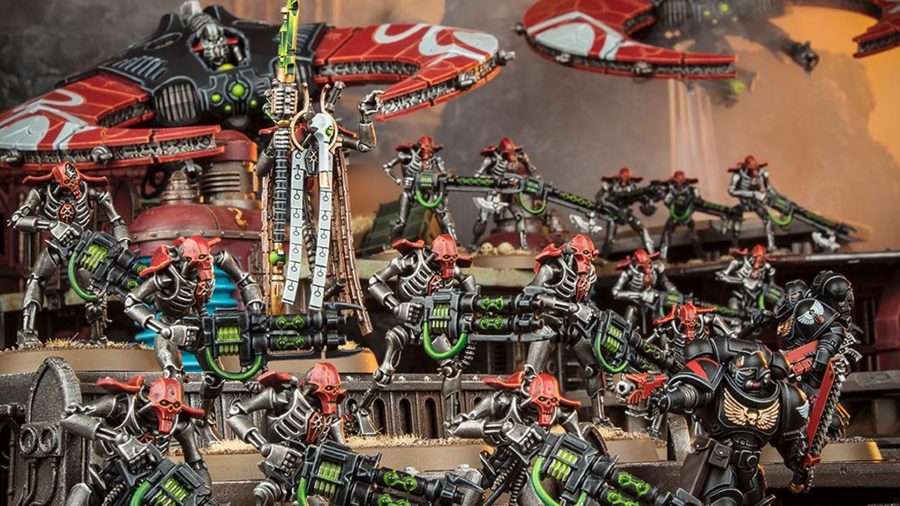
I also dusted up my forces with some weathering powder, liberally applying it with a soft brush and spray-varnishing it in place, in order to convey the feeling of them having been buried in the sands of a dead world for millennia. Alternatively, you can go bright and bold;there really is no limit with these hulking monstrosities.
There you have it. A quick start guide to the immortal Necron dynasties! There is so much to investigate, should you buy the codex – strategies, dynasties, custom dynasties, a whole range of troops – I didn’t even touch on the awesome Monolith (mainly because it’s something you likely won’t get to for months or years!)
Thanks to a Ninth Edition refresh, Necrons remain a fairly competitive army, with a wonderful wide range! Have fun, and remember, The Silent King’s Will Be Done.
